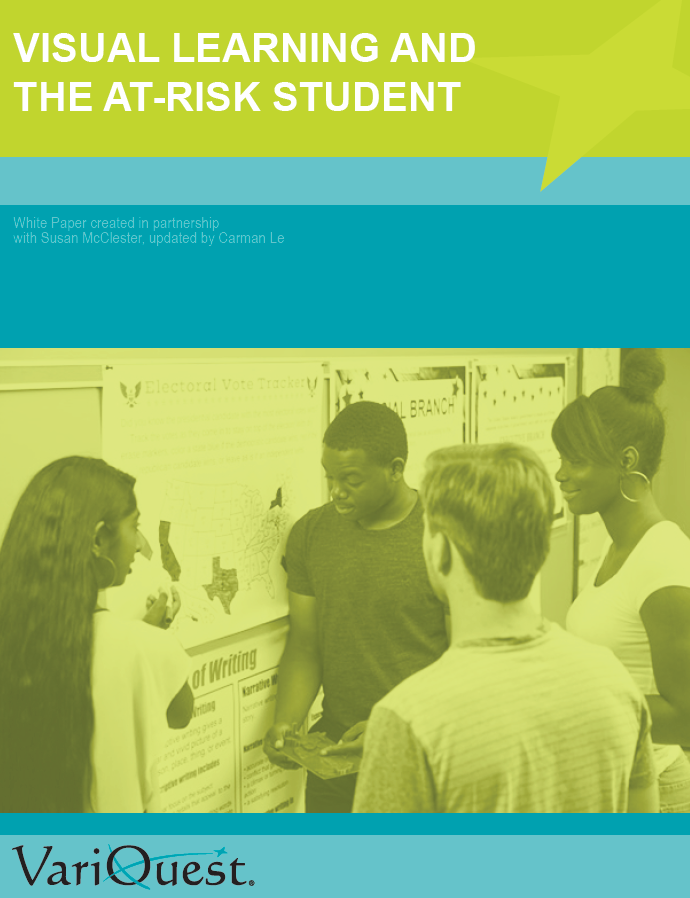Of the eight categories of intelligences, research suggests that visual-spatial learning is the most predominant.
When a teacher can train him or herself to think like a visual learner, modifying instruction isn't hard. Some fairly straightforward tweaks in the instructional approach can support learners across the spectrum in core curricular areas and beyond.
Visual and other sensory approaches to learning can transcend the barriers of language and culture, create a common language to bridge the generational gaps between educators and students, and open up new opportunities for societal and job equity for those students traditionally disenfranchised by the formal education system.
We at VariQuest know how important diversifying instruction is, to ensure the needs of all learners are met, so in partnership with Susan McClester and updated with the help of Carman Le, MAT, we've created a free eBook dedicated to successful strategies in catering to visual and sensory learning instruction - and we'd like to share it with you! Visual Learning for the At-Risk Student contains...



![[Video] Getting Over the Mid-Year Slump with The Curriculum Corner](https://content.cdntwrk.com/mediaproxy?url=https%3A%2F%2Finfo.variquest.com%2Fhubfs%2FBlog%2FThe_Curriculum_Corner%2FCurriculum%2520Corner%2520Video%2520Tips%2FTCC%2520Video%2520Thumb%2520Mid%2520Year%2520Slump%2520Thumb.jpg%23keepProtocol&size=1&version=1665679078&sig=4b170024ab69d22b22466ae05cd4036d&default=hubs%2Ftilebg-blogs.jpg)
![[Free Printables] Halloween Classroom Activity: You've been Boo'd!](https://content.cdntwrk.com/mediaproxy?url=https%3A%2F%2Finfo.variquest.com%2Fhubfs%2FCarman%2FHalloween%2FBood%2520Banner.jpg%23keepProtocol&size=1&version=1665679078&sig=524912a766f8a91acd81b442da9e1b6d&default=hubs%2Ftilebg-blogs.jpg)
![[Lesson Plan] Arbor Day Activities for Grades 4-6](https://content.cdntwrk.com/mediaproxy?url=https%3A%2F%2Finfo.variquest.com%2Fhubfs%2FLesson_Plan_PDFs%2Farbor%2520day%2520activities%2520blog%2520header.png%23keepProtocol&size=1&version=1713281322&sig=fa93c6558caab80b84ee1b7a3f74e75c&default=hubs%2Ftilebg-blogs.jpg)
![[Lesson Plan] SEL Photo Activities for Grades 5-7](https://content.cdntwrk.com/mediaproxy?url=https%3A%2F%2Finfo.variquest.com%2Fhubfs%2FLesson_Plan_PDFs%2FSEL%2520Photo%2520Activities%2520header.png%23keepProtocol&size=1&version=1712432018&sig=36043467659cdc58fd01a7c4e0b4e10f&default=hubs%2Ftilebg-blogs.jpg)
![[Lesson Plan] Pi Day Activities for Upper-Elementary and Middle School Students](https://content.cdntwrk.com/mediaproxy?url=https%3A%2F%2Finfo.variquest.com%2Fhubfs%2FLesson_Plan_PDFs%2FPi%2520Day%2520Activities%2520Blog%2520Header.png%23keepProtocol&size=1&version=1710189992&sig=ab49c07260f67fe83b83f01a871ed392&default=hubs%2Ftilebg-blogs.jpg)

![[Lesson Plan] Menu Math for Grades 3-6](https://content.cdntwrk.com/mediaproxy?url=https%3A%2F%2Finfo.variquest.com%2Fhubfs%2FHeader%2520Images%2Fmenu%2520math%2520header.png%23keepProtocol&size=1&version=1708632754&sig=fc5bd7de33f25f58a6ff8d497a3d009e&default=hubs%2Ftilebg-blogs.jpg)
![[Lesson Plan] Celebrate the Chinese New Year 2024!](https://content.cdntwrk.com/mediaproxy?url=https%3A%2F%2Finfo.variquest.com%2Fhubfs%2FCarman%2FCNY%25201-2018%2F%25E6%2581%25AD%25E5%2596%259C%25E7%2599%25BC%25E8%25B2%25A1.png%23keepProtocol&size=1&version=1708632755&sig=962e55db413d547df717013426c08ef8&default=hubs%2Ftilebg-blogs.jpg)
![[Free Holiday Printables] You've Been SOCKED!](https://content.cdntwrk.com/mediaproxy?url=https%3A%2F%2Finfo.variquest.com%2Fhubfs%2FHeader%2520Images%2Fyouve%2520been%2520socked%2520blog%2520header.png%23keepProtocol&size=1&version=1708632755&sig=fe271a837ddc50d0b0edfaa323d32280&default=hubs%2Ftilebg-blogs.jpg)
![[Lesson Plan] How to Write a Research Paper: The Writing Process](https://content.cdntwrk.com/mediaproxy?url=https%3A%2F%2Finfo.variquest.com%2Fhubfs%2FeBook%2FHow%2520to%2520Write%2520a%2520Research%2520Paper%2Fhow%2520to%2520write%2520a%2520research%2520paper%2520part%25202%2520blog%2520header.png%23keepProtocol&size=1&version=1708632756&sig=7a7f992b8eb3202d5b559b3528dee055&default=hubs%2Ftilebg-blogs.jpg)
![[Lesson Plan] How to Write a Research Paper: The Research Process](https://content.cdntwrk.com/mediaproxy?url=https%3A%2F%2Finfo.variquest.com%2Fhubfs%2FeBook%2FHow%2520to%2520Write%2520a%2520Research%2520Paper%2Fhow%2520to%2520write%2520a%2520research%2520paper%2520blog%2520header.png%23keepProtocol&size=1&version=1708632757&sig=fb6daae489601d8c8eb92778b80c580a&default=hubs%2Ftilebg-blogs.jpg)
![[Lesson Plan] Artificial Intelligence for the Writing Classroom](https://content.cdntwrk.com/mediaproxy?url=https%3A%2F%2Finfo.variquest.com%2Fhubfs%2FeBook%2FHow%2520to%2520Write%2520a%2520Research%2520Paper%2Fartificial%2520intelligence%2520writing%2520classroom%2520blog%2520header.png%23keepProtocol&size=1&version=1708632757&sig=1c98b19f762d343b74c8fc180604f91f&default=hubs%2Ftilebg-blogs.jpg)
![[Downloads] Classroom Coloring Activities for Fall Holidays](https://content.cdntwrk.com/mediaproxy?url=https%3A%2F%2Finfo.variquest.com%2Fhubfs%2Ffall%2520coloring%2520blog%2520header.png%23keepProtocol&size=1&version=1708632757&sig=d3323da683a8b5bf05557420031fd2e5&default=hubs%2Ftilebg-blogs.jpg)


![[Lesson Plan] Building Community With Kindness](https://content.cdntwrk.com/mediaproxy?url=https%3A%2F%2Finfo.variquest.com%2Fhubfs%2FHeader%2520Images%2Fbuilding%2520community%2520with%2520kindness%2520email%2520header.png%23keepProtocol&size=1&version=1692198532&sig=78399484e4c0b8174887d25918c70a9c&default=hubs%2Ftilebg-blogs.jpg)
![[Download] Engage Every Learner® Content Fall 2023 Expansion Pack](https://content.cdntwrk.com/mediaproxy?url=https%3A%2F%2Finfo.variquest.com%2Fhubfs%2Fimages%2FeContent%2520Screenshots%2FFall%25202023%2520Release%2520Banner%25201200X400.png%23keepProtocol&size=1&version=1691693048&sig=27c99d424a13eed4e3bc55ebd2ca7b92&default=hubs%2Ftilebg-blogs.jpg)
![[Printable] My Logins and References Notebook Inserts](https://content.cdntwrk.com/mediaproxy?url=https%3A%2F%2Finfo.variquest.com%2Fhubfs%2FHeader%2520Images%2Fmy%2520logins%2520and%2520references%2520blog%2520header.png%23keepProtocol&size=1&version=1689778862&sig=e728eacac23bc55826da0f1cd1af5247&default=hubs%2Ftilebg-blogs.jpg)

![[Download] Writing With Caution Classroom Poster and Activities](https://content.cdntwrk.com/mediaproxy?url=https%3A%2F%2Finfo.variquest.com%2Fhubfs%2FHeader%2520Images%2Fwriting%2520with%2520caution%2520poster%2520header.png%23keepProtocol&size=1&version=1686837986&sig=38d5bd4d93ebd2148488bd7c71770535&default=hubs%2Ftilebg-blogs.jpg)
![[Printable] Don't Keep it Bottled Up Compliment Cards](https://content.cdntwrk.com/mediaproxy?url=https%3A%2F%2Finfo.variquest.com%2Fhubfs%2FHeader%2520Images%2Fcompliment%2520cards%2520email%2520blog%2520header.png%23keepProtocol&size=1&version=1684332412&sig=a06221ee156b84fe65c26454d21df39b&default=hubs%2Ftilebg-blogs.jpg)
